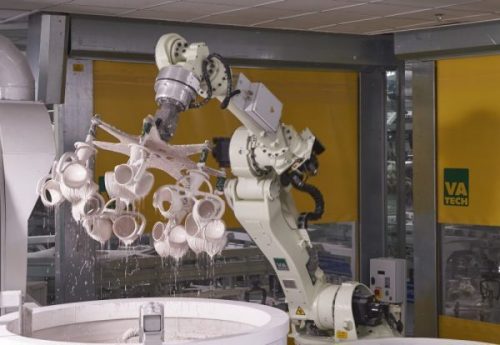Robotics in Investment Casting: Uses and Benefits
There is no question that robotics is used throughout manufacturing and logistics industries. When it comes to the supply chain, robotic arms perform repeatable tasks at high speeds while maintaining quality. Yet this technology is not overlooked in the component manufacturing fields. Robotics are also found in investment casting processes to create parts.
How Robotics are Used in Investment Casting Processes
Investment casting is a method where a wax pattern is dipped into a ceramic slurry to create the shell mold. Then the molten metal is poured inside and hardened to produce the part that later undergoes finishing. Throughout the entire operations, automation and robotics are used. Many wax injection machines are automatic or semi-automatic as a conveyor belt moves the patterns along the plant floor to the different process departments.
Using robotic arms and conveyor belts allows the patterns to be moved to different facility areas with little human handling. This strategy minimizes the likelihood of the pattern becoming damaged while it is moved. Also, the robotic arms help to create more molds per minute, reducing lead times for high production runs.
Another process that uses robotics is the wax pattern assembly. Some wax trees have many parts. These parts become affixed to the rest of the sprue to create the pattern assembly. Robotic arms perform this time-consuming task around the clock ensuring all pattern parts are connected in a consistent manner.
Shell making processes also rely on robotic arms that will dip the wax pattern into the ceramic slurry which often involves multiple layers. Using robots in the process promotes greater levels of quality consistency and worker safety. The robotic arms also ensure that every wax pattern receives an even coat across all surfaces.

Robotics may also be used in other processes. After the metal component is produced, robots may be used during the cleaning and cutting of the part as well as the secondary machining process. Laboratory testing processes may also have robotics to perform measures and determine part accuracy,
Benefits of Robotics in Investment Casting
Repeatability: Robotic arms are programmed to perform their specific tasks based on the inputted data. This process ensures that every component produced will have the same accurate dimensions and quality even for high production volumes.
Consistency: Robots cannot stray from their programmed settings. Parts and components maintain their consistency even with the robots operating 24 hours a day and 7 days a week.
Boost Productivity: Robots may run at all hours of the day. They do not require breaks and their productivity does not change due to the long hours. This advantage helps manufacturers to increase their productivity and reduce lead times.
Investment casting processes have many redundant and complex functions. Using robotics to perform these functions can provide a range of benefits for customers. Impro has used robotic technologies throughout its investment casting facilities for over a decade. To learn more about our investment processes, contact Impro.